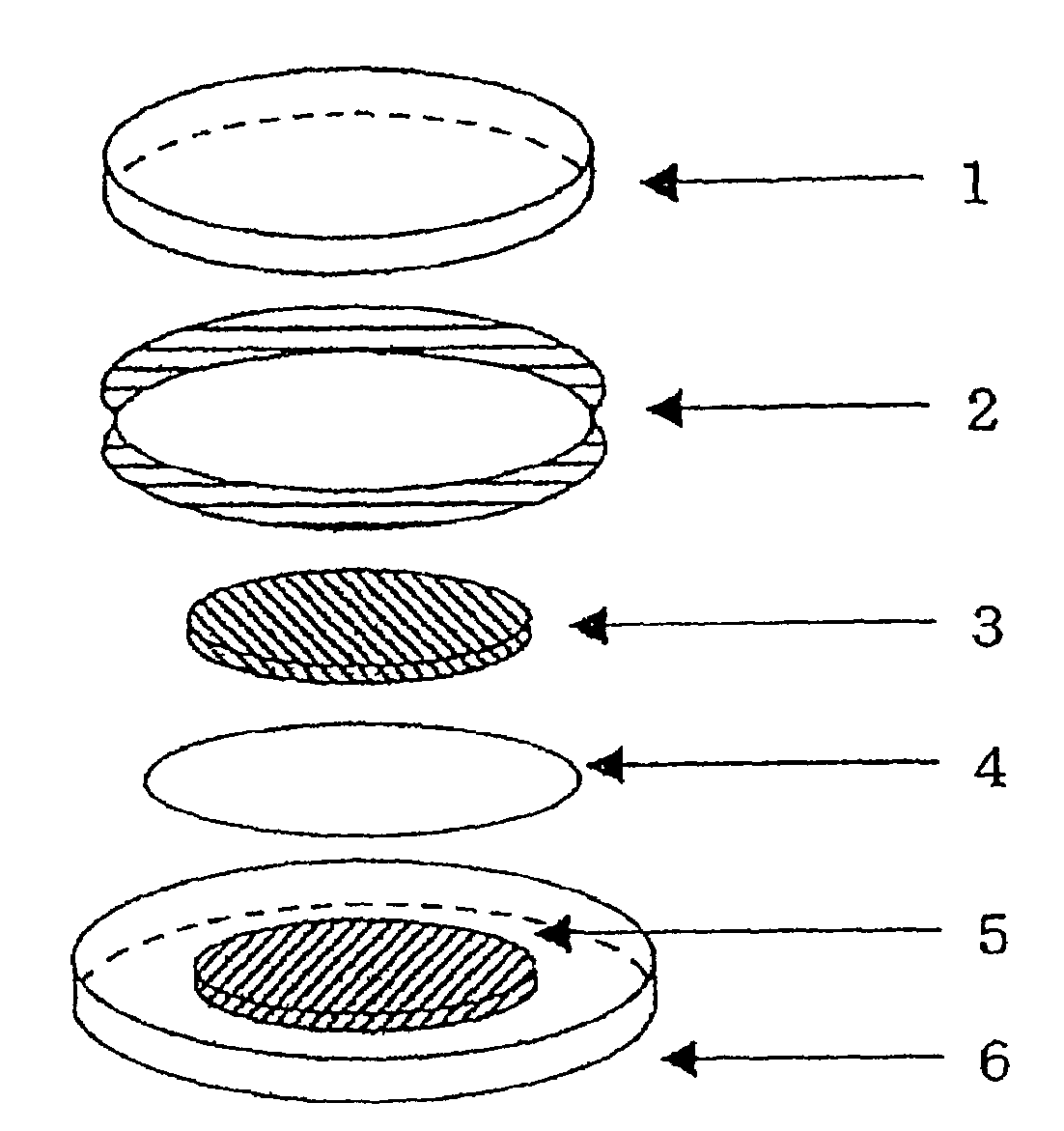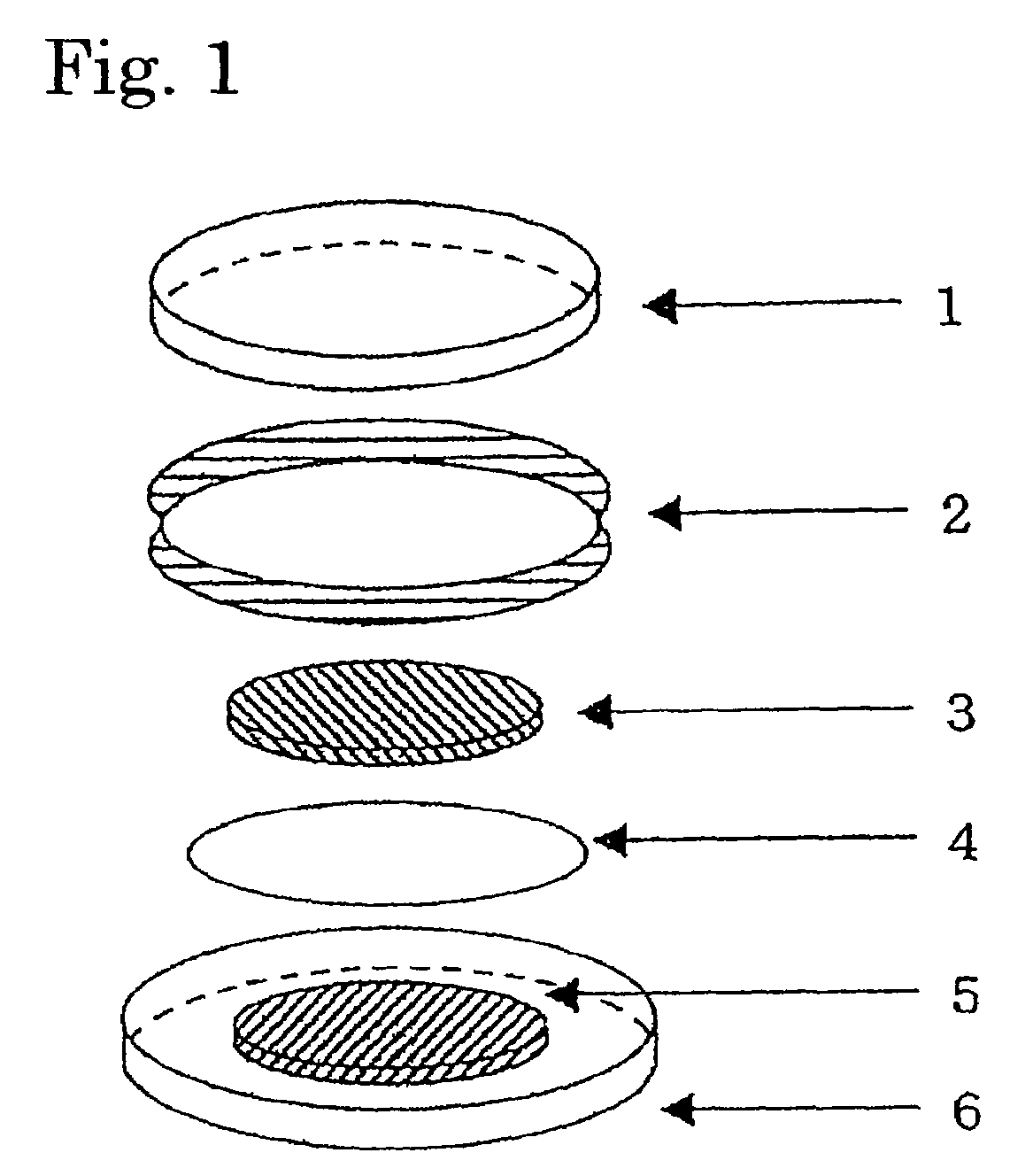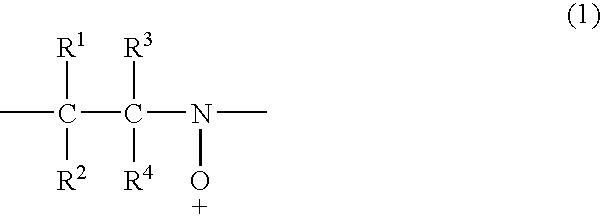Secondary battery with a nitroxyl polymer active material
a polymer active material and secondary battery technology, applied in the field of secondary batteries, can solve the problems of limited excitons generated concentration, low efficiency in dissociation bond reformation, and prone to decrease in capacity, and achieve the effects of superior charge and discharge cycle characteristics, higher energy density, and larger capacity
- Summary
- Abstract
- Description
- Claims
- Application Information
AI Technical Summary
Benefits of technology
Problems solved by technology
Method used
Image
Examples
embodiment 1
[0065]300 mg of poly (2,2,3,3-tetramethyl-ethylene-nitroxyl) which is a chemical compound represented by formula (A), 600 mg of graphite-powders, and 100 mg of polytetrafluoroethylene resin binder were measured, and they are dry mixed by kneading for 10 minutes using an agate mortar. As a result of measuring the molecular weight of the poly(2,2,3,3-tetramethyl-ethylene-nitroxyl) by GPC, the weight-average molecular weight is 8900 (vs polystyrene conversion) and the dispersion ratio (weight-average molecular weight / number-average molecular weight) is 1.82.
[0066]The obtained mixture was extended to a thin film by applying pressure with a roller. After drying it overnight at 80° C. inside a vacuum, it was punched to a circular shape of 12 mm diameter. The coin-shaped positive electrode is formed accordingly. The weight of this electrode is 18.8 mg.
[0067]Then, the obtained electrode was immersed into an electrolyte solution to impregnate the electrolyte solution into the pores inside th...
embodiment 2
[0072]The coin-shaped battery was produced according to the same method as in Embodiment 1 except for using the poly (2,2,3-trimethyl-3-propylethylene-nitroxyl) represented by formula (B) in place of the poly (2,2,3,3-tetramethyl-ethylene-nitroxyl). The weight of positive electrode of this coin-shaped battery is 20 mg.
[0073]To the coin-shaped battery produced, it is charged by sending a constant current of 1 mA until reaching the voltage of 4.2 V, and after that discharging were carried out at a constant current of 1 mA. As a result of that, the voltage became constant for 48 minutes at the region of 3.6 V, and suddenly dropped after that. Its performance as a battery was confirmed from this. The battery is charged again at the voltage drop of 2.2V, and further, charging and discharging tests were repeated 50 times in the region of 4.2 to 2.2 V. As a result of the tests, constant voltages were observed at the region of 3.6 V and the performance as a secondary battery was confirmed. ...
embodiment 3
[0075]The coin-shaped battery was produced according to the same method as in Embodiment 1 except for using the poly (2,3-dimethyl-2,3-diphenylethylene-nitroxyl) represented by formula (C) in place of the poly (2,2,3,3-tetramethyl-ethylene-nitroxyl). The weight of positive electrode of this coin-shaped battery is 19.1 mg.
[0076]To the coin-shaped battery produced, it is charged by sending a constant current of 1 mA until reaching the voltage of 4.2 V, and after that discharging were carried out at a constant current of 1 mA. As a result of that, the voltage became constant for 25 minutes at the region of 3.6 V, and suddenly dropped after that. Its performance as a battery was confirmed from this. The battery is charged again at the voltage drop of 2.2V, and further, charging and discharging tests were repeated 50 times in the region of 4.2 to 2.2 V. As a result of the tests, constant voltages were observed at the region of 3.6 V and the performance as a secondary battery was confirme...
PUM
| Property | Measurement | Unit |
|---|---|---|
| diameter | aaaaa | aaaaa |
| weight | aaaaa | aaaaa |
| voltage | aaaaa | aaaaa |
Abstract
Description
Claims
Application Information
 Login to View More
Login to View More - R&D
- Intellectual Property
- Life Sciences
- Materials
- Tech Scout
- Unparalleled Data Quality
- Higher Quality Content
- 60% Fewer Hallucinations
Browse by: Latest US Patents, China's latest patents, Technical Efficacy Thesaurus, Application Domain, Technology Topic, Popular Technical Reports.
© 2025 PatSnap. All rights reserved.Legal|Privacy policy|Modern Slavery Act Transparency Statement|Sitemap|About US| Contact US: help@patsnap.com



